Minimalist design isn’t about having empty rooms; it’s about being clear. When you take away the extra stuff, what you have left should feel calm, useful, and quietly beautiful. The twelve DIY ideas below keep that spirit front and center. They are simple improvements you can make in a weekend with honest materials, neutral color stories, and a light touch. You’ll paint with a purpose, style shelves with room to breathe, hide clutter in smart storage, and add texture without making the space feel crowded. Each idea is based on one simple move that changes a room without going over budget or disrupting the flow of your home. You can do them in any order or mix and match them. The goal is still the same: make rooms that look easy because everything has its place, light moves freely, and your home finally feels as peaceful as it should.
1. Paint a Soft, Matte Neutral Wall for Instant Calm
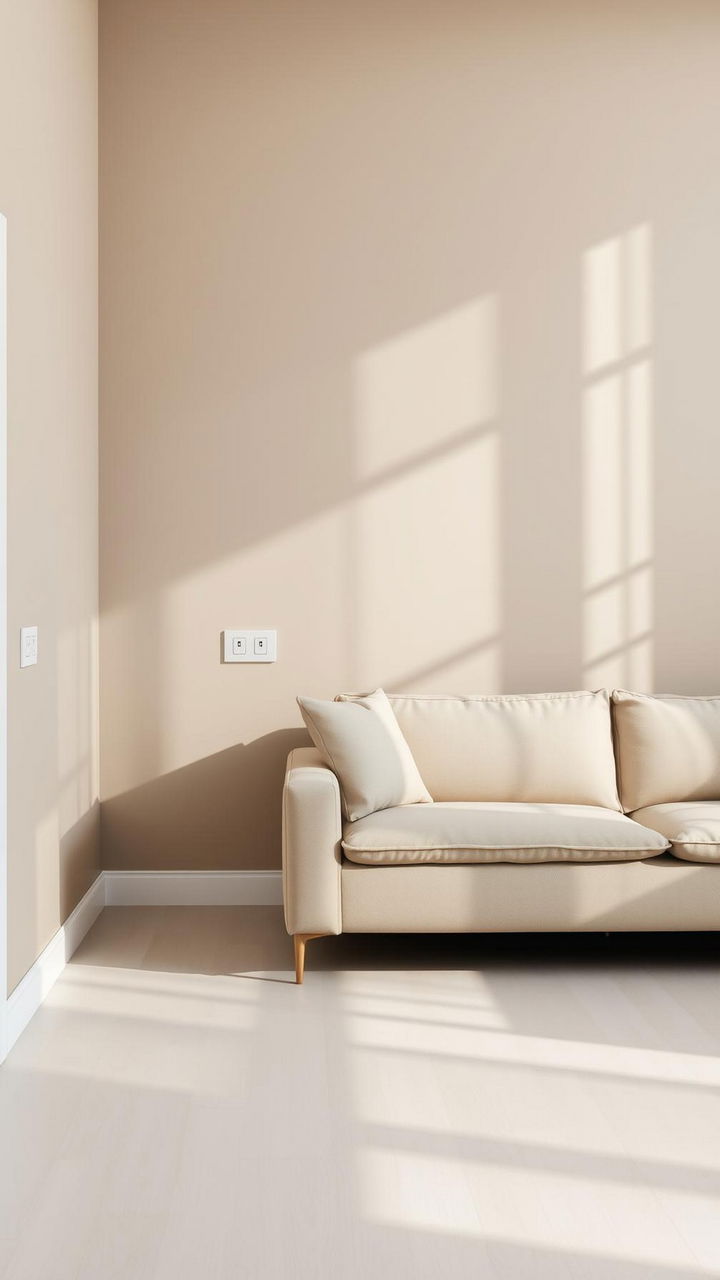
A single coat of soft, matte neutral paint can change the look of a whole room. Fill in the holes, sand them down a little, and then prime them. Try out two or three swatches from the same family, like warm greige, pale mushroom, or stone. Then, choose the one that looks best in your lighting. To get clean edges, use a good angled brush. To get a velvety finish, use a microfiber roller. To hide small flaws and reduce glare, keep the sheen low (matte or eggshell). For a smooth look, paint the covers and vents of the outlets the same color. To get soft movement without a pattern, mist a second tone that is only half a shade darker in loose, overlapping strokes. Think of cloudiness, not contrast. A single quiet wall behind a couch or headboard is all you need to anchor the room and make everything else feel planned.
2. Float Minimal Shelves and Style with Negative Space
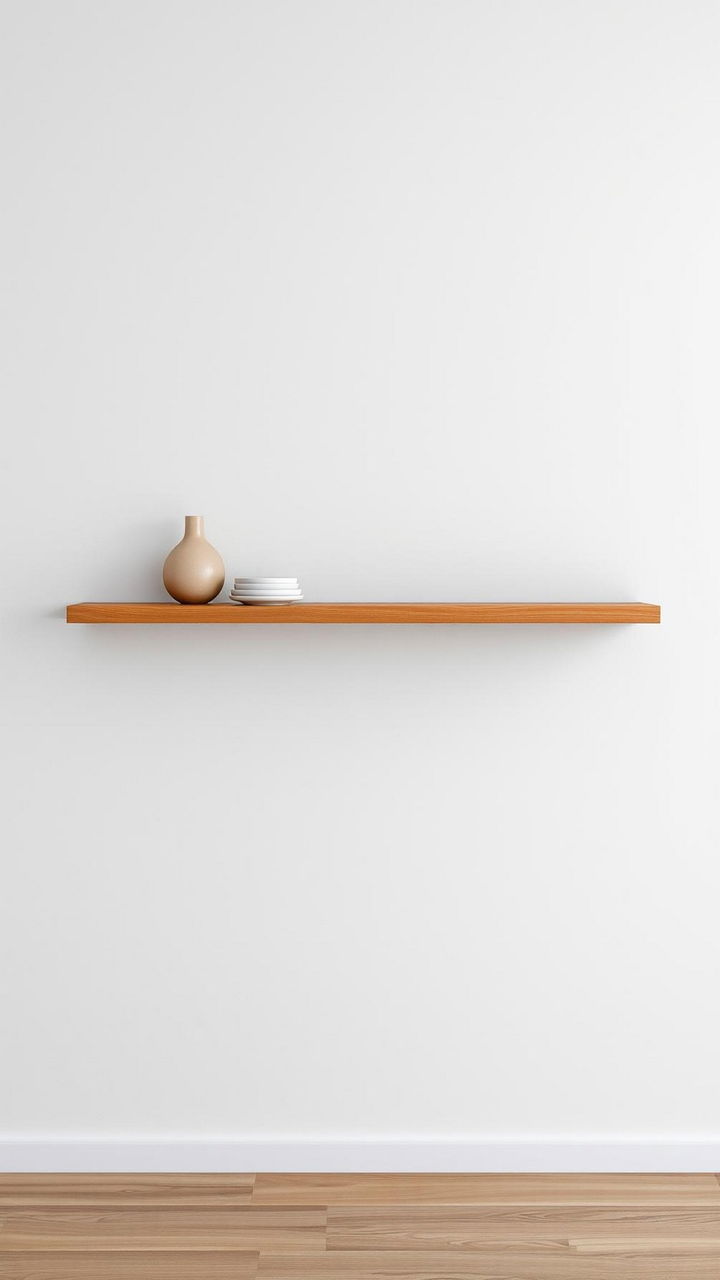
Floating shelves give you storage space without making the room look cluttered, especially if you style the air as much as the things. Pick thin shelves made of wood or painted MDF that match your trim and don’t have brackets. Make sure they are level and evenly spaced, and stop before you get to the corners. Breathing room is important. Make a short list of things to keep, like two books, a small vessel, a sculpture, and maybe a picture in a frame leaning against the wall. Put things in groups of three or five and change the height while keeping the color palette tight. Leave at least a third of each shelf empty so that your eyes can rest. For a kitchen, only keep things you use every day, like two bowls, three glasses, and a board. This will keep the shelves from looking like a museum. Wipe it down once a week, reset it once a month, and switch out one thing whenever you add something new.
3. Build a Slim Entry Bench with Hidden Storage
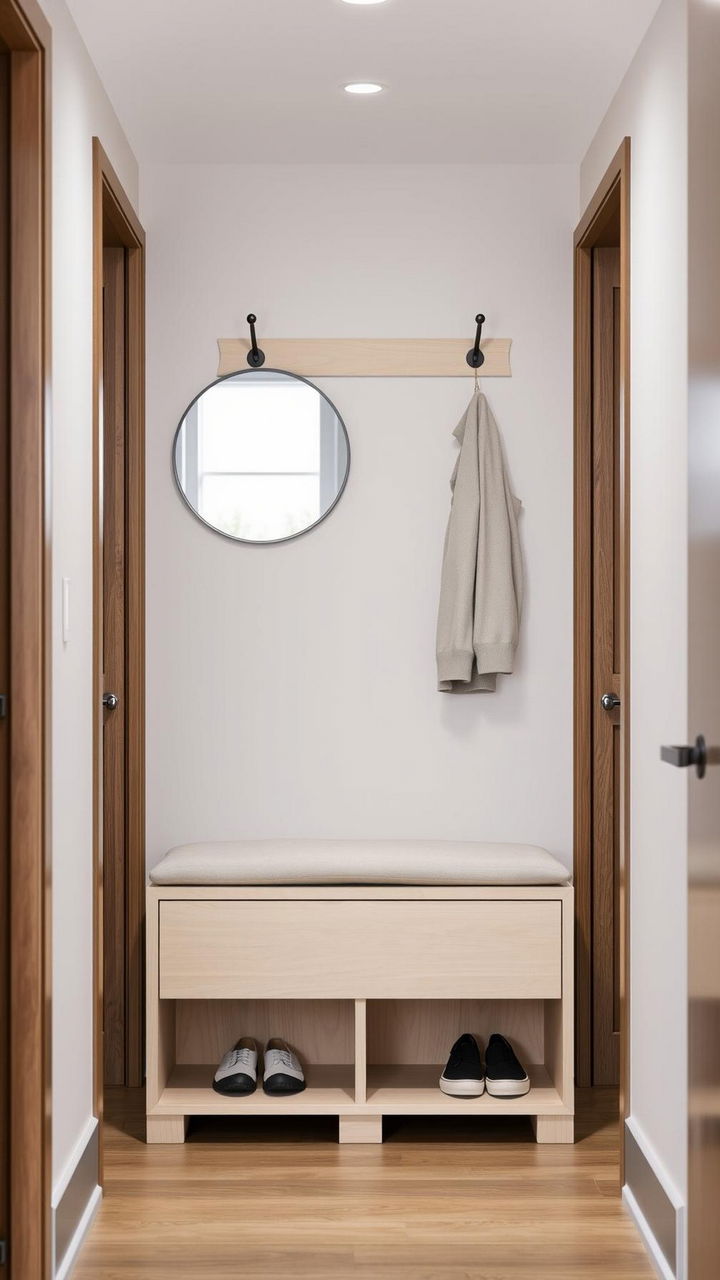
Your bench decides whether the narrow entry is a mess or a calm place. Cut some plywood to the depth of your hallway (usually 12 to 14 inches), glue and screw it together, and then add a hinged top for drop-in storage. Add an edge band for a polished look, and then sand it down until it’s silky smooth. You can either leave the wood clear or stain it lightly. To make it look like it’s floating, add four block legs or a recessed plinth. To make a thin cushion for the top, wrap foam in neutral fabric and attach it to a plywood base with a staple gun. Put up two or three small hooks and hang a round mirror on them to reflect light. Keep surfaces strict: one tray for keys, one basket for shoes, and nothing else. That little rule at the door sets the mood for the rest of the house.
4. Craft Oversized Monochrome Art on a Budget
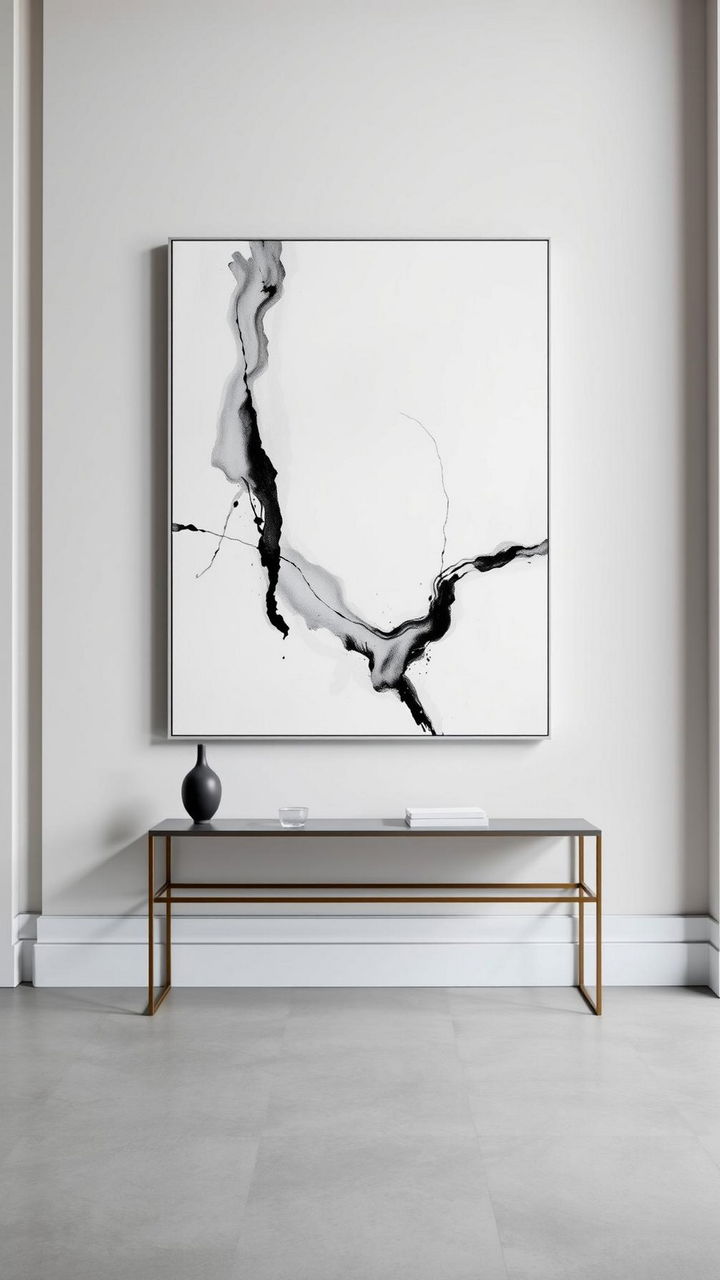
Big art and a simple room are the quickest way to create minimalist drama. Primed plywood works, but stretch canvas is the best. Use a wide brush, foam roller, or taped curve to paint it a warm white and then add a single gestural shape in charcoal, bone, or black. Leave a lot of empty space in the composition. When it’s dry, frame it in bare wood or paint the frame to match the wall so that the shape looks like it’s floating. Hang it in the middle above a couch or lean it casually on a console; don’t put it in groups. The scale does the talking, so don’t let other things in the room make noise. If you’re worried about it lasting, draw the shape on kraft paper first and then move it. The end result looks like a custom piece of art without the gallery price.
5. Hang Linen Curtains High and Wide to Soften Lines
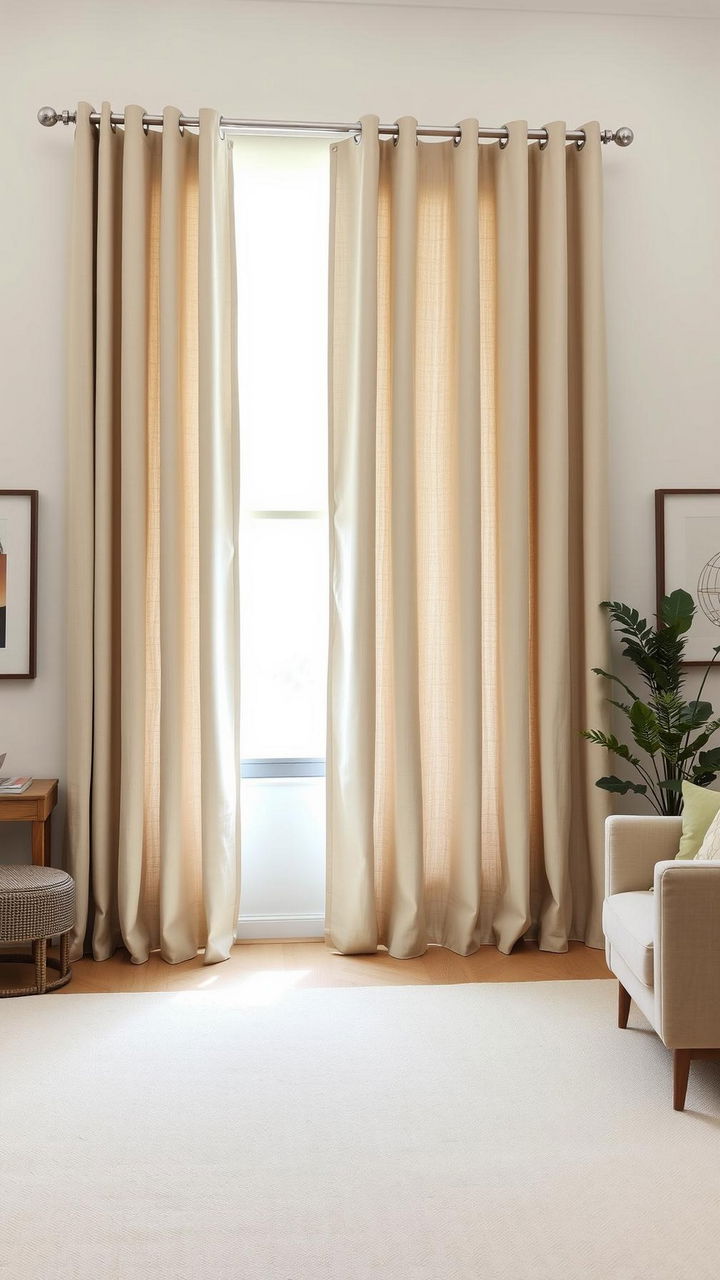
Minimalism still likes things that are soft. Linen panels that go all the way to the floor let in light without getting in the way of your view. Place your rod 4 to 8 inches above the window (or just below the ceiling) and make it 8 to 12 inches longer than the frame so that the panels stack off the glass. For clean falls, use simple rings with clips or hidden pleat hooks. Use iron-on tape to hem the fabric so it just touches the floor and doesn’t puddle. Choose oatmeal, undyed, or soft white; stay away from busy patterns. If privacy is important, put a thin blackout roller shade inside the frame. It won’t be seen when it’s up. Two panels for each window are enough; don’t use tiebacks. The soft movement of the fabric softens the room’s hard edges, and the higher mount quietly extends the walls, making even small spaces feel taller and more peaceful.
6. Swap Harsh Fixtures for Warm, Layered Minimal Lighting
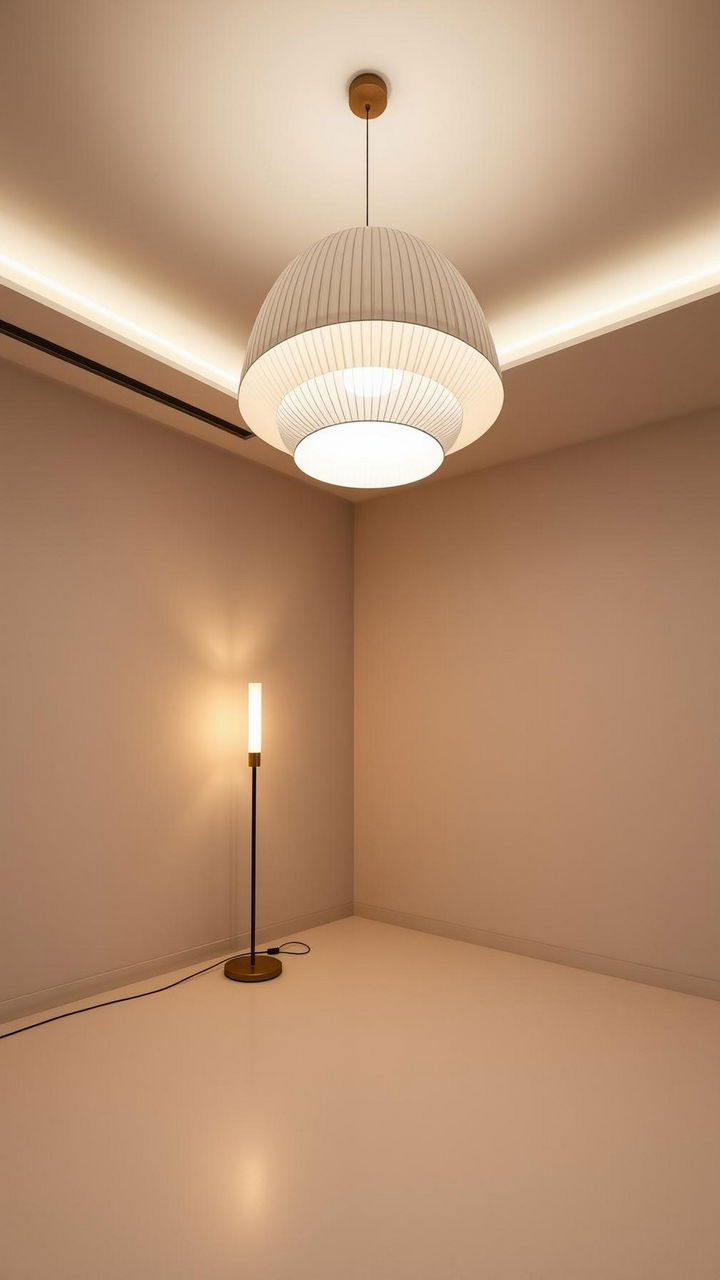
Rooms that are great at being simple shine instead of glare. Switch out the cold, bright bulbs for warm white LEDs (look for a comfortable temperature on the packaging) and add two more layers: a low lamp and a soft overhead. A rice-paper pendant or a simple drum shade gives off soft light, and a slim table or floor lamp does the work. For winding down at night, put at least one source on a dimmer. Paintable channels can hide cords, and you can run them cleanly down corners and keep switches easy to reach without making surfaces messy. The light palette—warm, even, and adjustable—makes simple rooms feel cozy at night. As a final step, go outside at night and come back in. If you see bright spots or harsh shadows, move the lamps around until everything looks soft and balanced.
7. Style a Minimal Coffee Table with the Rule of Three
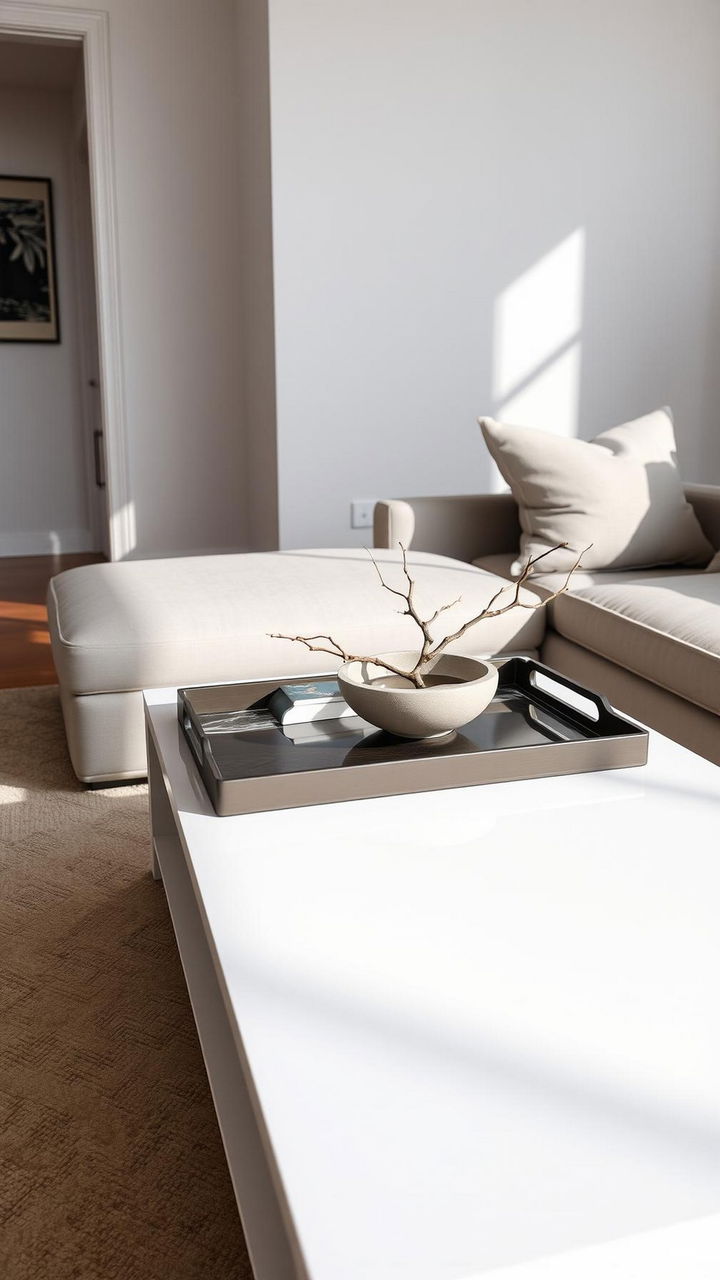
A coffee table can get cluttered quickly. One tray, one sculptural object, and one living thing will keep it classy. Pick a low, smooth tray made of wood, stone, or lacquer to hold your coasters and remotes. Put in one thing that stands out, like a curved bowl, a simple candle, or a handmade vessel. Finish with life: a small branch in water, a neat stack of two books, or a short-stemmed bouquet that has been cut low. Leave a lot of empty space for laptops and mugs. Use a shallow box under your table to hide chargers and keep cables from getting tangled if it has storage. When you dust, change the arrangement by moving the branch, turning the book, and stopping when the surface looks clear and purposeful from the main seating area.
8. Create a Low, Quiet Platform Bed and Edit the Nightstands
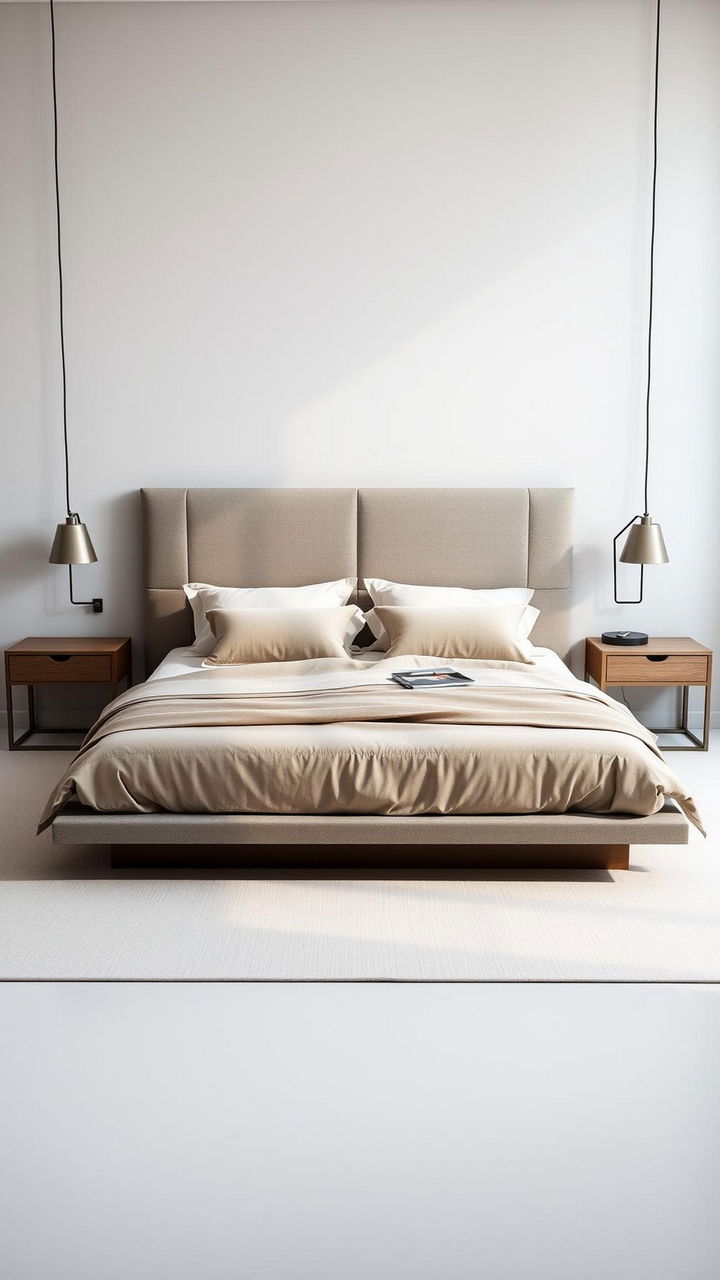
Minimalist bedrooms put sleep first. Make a simple platform out of plywood with mitered edges or a simple frame with slats. Make sure the profile is low so the mattress can float. For a lighter look, don’t use a headboard. Instead, use a plain panel covered in fabric and mounted a few inches above the mattress. Pick bedding that is crisp and neutral, and a throw that has some texture. Nightstands should be twins or closely related, and each should have one drawer to hide the mess that builds up at night. A book, a small dish, and one lamp on each side are all you need. Put stray cables behind the frame and keep tech for bedtime in a small box where you can’t see it. The clean planes, soft texture, and strict surfaces all work together to help the room breathe, which helps you breathe as well.
9. Use a Single Sculptural Plant as a Living Accent
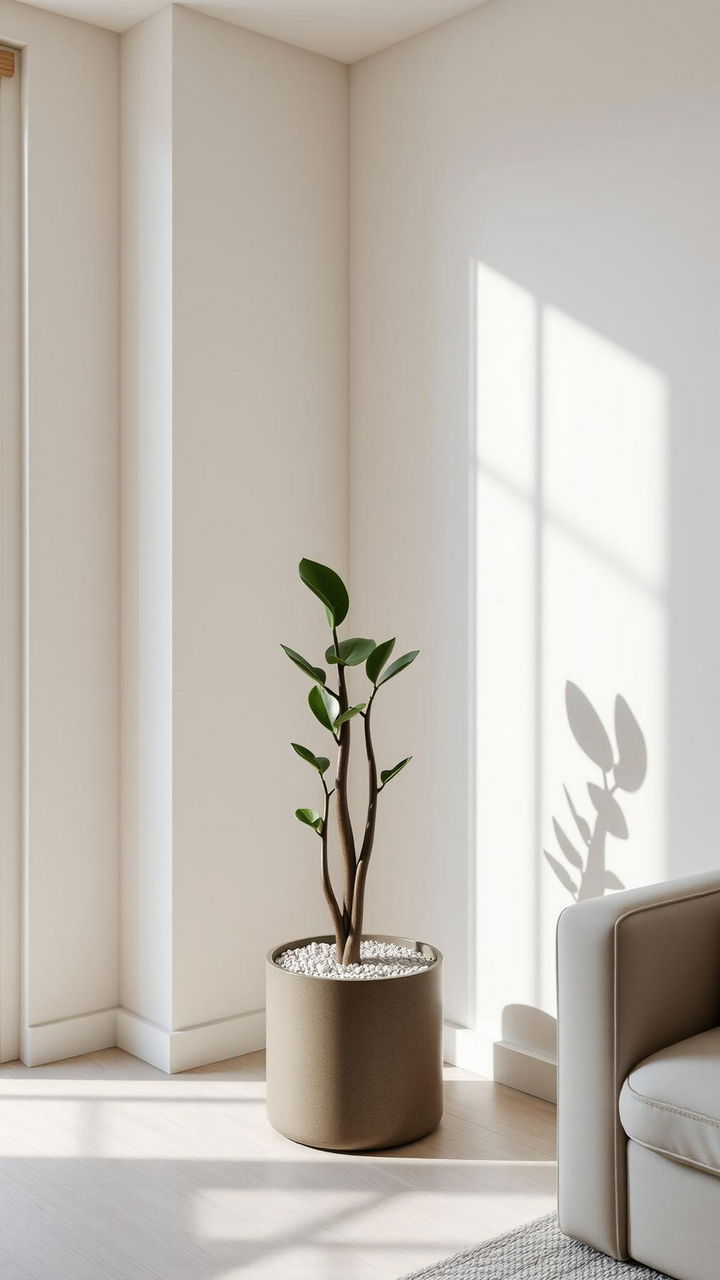
When kept in check, plants can be very strong. Choose one sculptural plant, like an olive, rubber, ficus, or monstera, and give it room to grow. Put it in a simple cylinder or tapered planter with a soft texture that matches the tray. Fine gravel mixed with topsoil makes for a neat finish and makes it easier to dust. Put the plant next to a window so it can breathe. Don’t put it next to art or shelves. To keep an airy shape, trim the plant and turn it every month to make sure it grows evenly. Dust the leaves so they catch the light. If your room doesn’t get much light, try putting a tall, dried branch in a glass cylinder. It will give you the same vertical rhythm without much effort. One living gesture makes the thin envelope softer while keeping your sightlines steady.
10. Add Quiet Texture with a Natural-Fiber Rug and Two Pillows
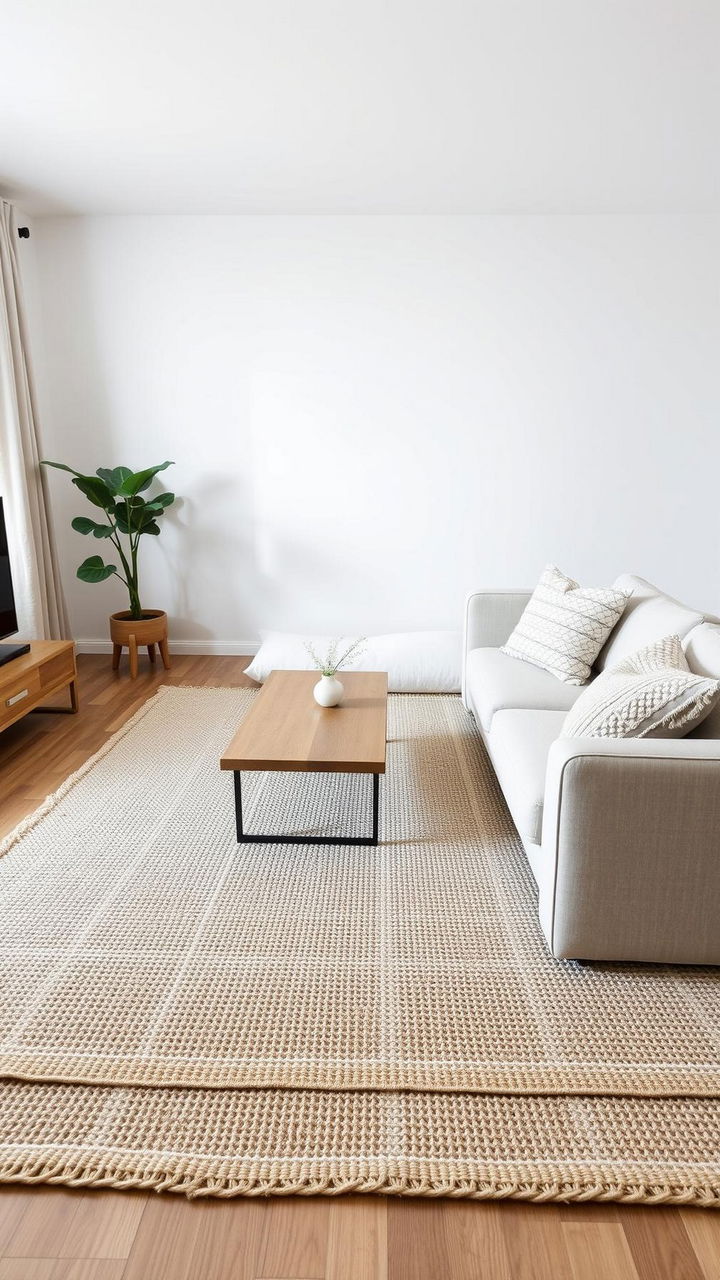
Minimalism doesn’t mean being flat. Touch, not pattern, will add depth. Put down a natural-fiber rug, like wool, jute, or cotton, in a soft neutral color that doesn’t stand out too much. Make it big enough for the front legs of the seating to rest on; bigger looks calmer. Add two pillows that are both tonal and textural, like bouclé, slub linen, or a subtle rib, to match the rug’s warmth. Don’t use busy patterns or shiny synthetics. That set of textures completes the look if you have leather or smooth wood furniture. Keep throws neat and folded; one is enough. The limited color scheme makes the room feel layered and finished while still letting it breathe. It’s also easy to clean: just shake, brush, and reset in a few minutes.
11. Install a Slim Picture Ledge for a Rotating, Minimal Gallery
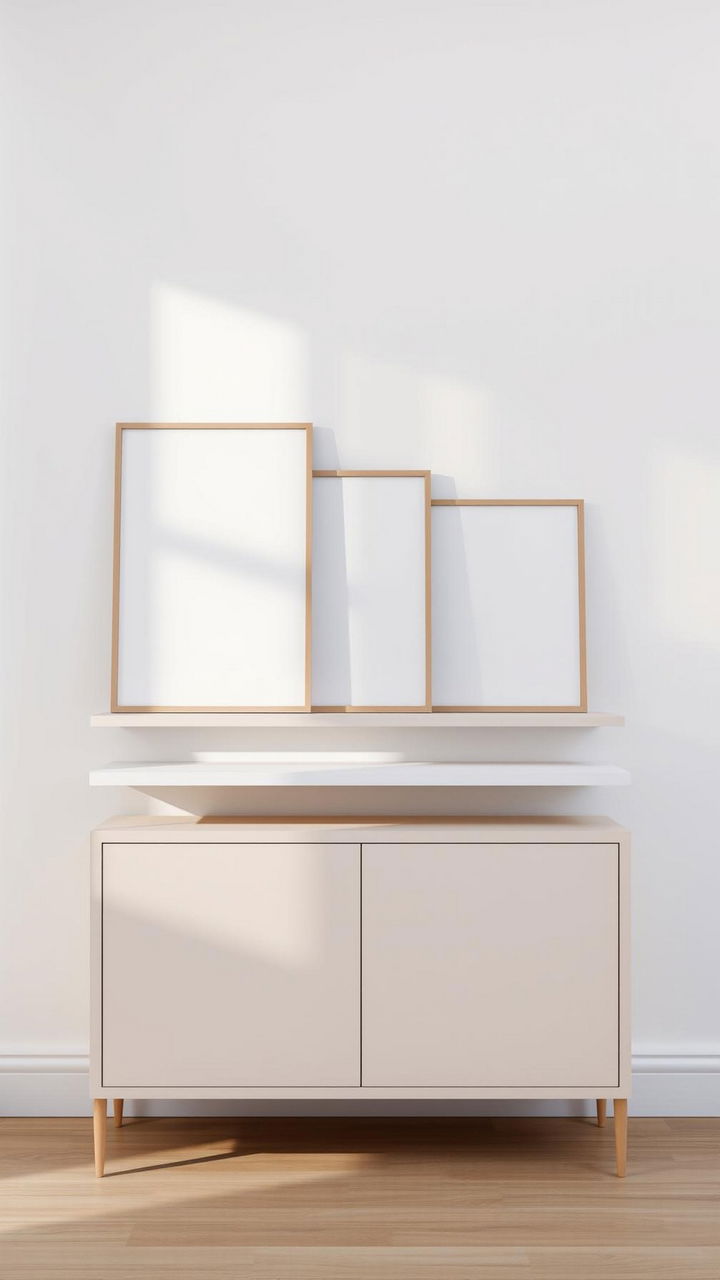
A shallow picture ledge lets you show off art without putting holes in the walls or making them look busy. You can make one out of a single board and a small face lip, or you can buy a simple ledge that is already made. To make the art look like it’s floating, paint it the same color as the wall. Choose three to five pieces that are similar in tone, like photographs, line drawings, or abstract studies, and make sure they overlap a little bit to create rhythm. Make sure the frames are thin and the same size. Don’t hang, lean, or edit seasonally. When you bring in a branch or change the throw, swap one piece for another. This rotating method lets you change things up without making your room look cluttered, and the ledge’s single clean line adds to the calmness of your room’s geometry.
12. Make a Spa-Simple Bath: Decant, Edit, and Warm the Floor
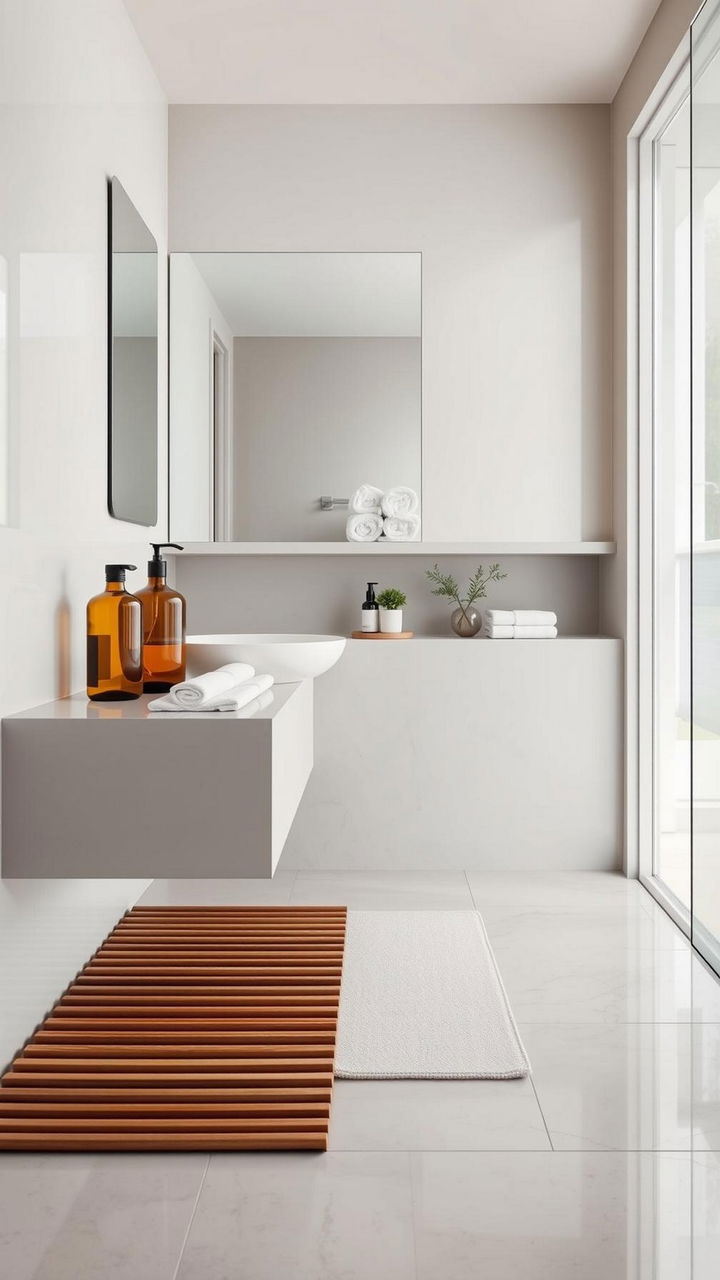
Labels, plastic colors, and scattered bottles make bathrooms noisy quickly. Put daily necessities in amber or clear pump bottles and label them in a way that isn’t too obvious. Only keep things you use every day on open surfaces, and put backups in a single box with a lid. Pick a single color for all the towels and roll or fold them all the same way. To add warmth without adding bulk, replace a fuzzy mat with a slatted wood or quick-dry woven runner. If the counters still seem busy, put a shallow shelf above the sink to keep everyday items off the surface. When you get rid of the visual noise, the tile and light take center stage, and the whole room looks like a spa.
Conclusion
Minimalist DIY is more about editing, refining, and finishing well than buying things. Neat wiring, soft textiles, and one strong gesture per room help keep the noise down. Begin with paint, then add shelves, storage, texture, light, and life in a slow, deliberate, and beautiful way.

